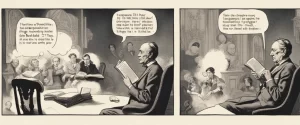——How To by Randall Munroe & Brief Answers to the Big Questions by Stephen Hawking

In the vast realm of popular science literature, few authors have captivated and democratized complex ideas like Randall Munroe and Stephen Hawking. Their books, How To and “Brief Answers to the Big Questions” respectively, delve into the mysteries of the universe, tackling fundamental inquiries with clarity, wit, and intellectual prowess. As readers embark on a journey through these two distinct works, each penned by their respective authors, a comparative analysis unfolds, revealing striking similarities and intriguing differences in their approach, content, and underlying philosophy.
Randall Munroe, the creator of the celebrated webcomic xkcd, wields his unique brand of humor and illustration in “How To” to explore peculiar scenarios and offer ingenious solutions. In contrast, Stephen Hawking, the eminent theoretical physicist, renowned for his groundbreaking work in cosmology and black holes, imparts his final insights on humanity’s grandest questions in his acclaimed book, “Brief Answers to the Big Questions.” Despite their differing origins, both authors share a common purpose: to illuminate the complexities of science and leave readers with a newfound understanding of our world.
The objective of this comparative study is to delve beyond their literary achievements and discern the distinct approaches taken by Munroe and Hawking, exploring how they navigate the delicate intersection of science, art, and human curiosity. By analyzing their writing styles, thematic priorities, and scope of exploration, we can gain insight into the nuances of their philosophies, shedding light on their contributions to the popularization of science.
Through a detailed examination of these two captivating works, we will uncover the diverse ways that Munroe and Hawking engage with and captivate their readers. By exploring the impact of humor, the role of visual illustrations, and the balance between scientific rigor and accessibility, we will uncover the underlying motivations driving their respective narratives. Moreover, we will draw comparisons between the approaches of a scientist-turned-author and a cartoonist-turned-science communicator, shedding light on the implications of their unconventional paths as they strive to make intricate scientific concepts comprehensible to a broad audience.
In doing so, this comparative study will not only highlight the individual merits of “How To” and “Brief Answers to the Big Questions,” but also offer a deeper understanding of the dynamic landscape of popular science literature. By examining the parallels and distinctions between these two works, we can appreciate the power of storytelling, humor, and art in elucidating complex scientific ideas, leaving readers inspired and enlightened about the wonders of the universe.
Brief Summary of Two Books
How To by Randall Munroe
“How To” by Randall Munroe is a thought-provoking and entertaining guide that takes a humorous approach to explaining complex concepts and solving hypothetical scenarios. Munroe, a former NASA roboticist and the creator of the popular webcomic xkcd, explores a wide range of topics in a unique and simplified manner.
The book is divided into chapters, each focusing on a different question or problem that Munroe attempts to answer or solve. Some of these questions include: How can you perform common tasks in the most effective and efficient way? How can you build a lava moat around your house? How can you power your home using natural sources like volcanoes or the sun? Alongside these practical queries, Munroe also tackles more abstract questions like “How to jump really high?” or “How to take a selfie with the Earth?”.
Munroe employs his trademark stick-figure illustrations and witty writing style to explain complex scientific and mathematical concepts, giving readers a deeper understanding of the underlying principles. He provides both practical and outlandish solutions to the posed questions, often with hilarious and unexpected outcomes.
In addition to teaching readers about science and problem-solving, Munroe also highlights the importance of critical thinking. He encourages readers to challenge assumptions, question traditional approaches, and approach problems with curiosity and creativity.
Overall, “How To” combines humor, intelligence, and scientific knowledge to provide an enjoyable and educational reading experience. It offers a unique perspective on everyday problems and inspires readers to seek unconventional solutions while fostering a deeper understanding of the world around us.
Brief Answers to the Big Questions by Stephen Hawking
Brief Answers to the Big Questions” is a posthumously published book by the renowned physicist Stephen Hawking. In this book, Hawking addresses various profound questions that have fascinated humanity throughout history. Divided into ten chapters, he explores topics such as the origins of the universe, the existence of extraterrestrial life, the possibility of time travel, the future of AI, and the dangers facing our planet.
Hawking presents complex scientific concepts in a manner accessible to general readers, combining his scientific knowledge with his unique perspective on life and the universe. He delves into the mysteries surrounding the Big Bang theory, the nature of black holes, and the potential for humans to colonize other planets. Furthermore, he emphasizes the importance of scientific progress and the role it plays in shaping our understanding of existence.
Apart from scientific inquiries, Hawking also delves into ethical and philosophical questions. He discusses the threats posed by climate change, the ethics of genetic engineering, and the dangers of artificial intelligence, highlighting the responsibilities we have towards the planet and future generations.
Throughout the book, Hawking remains optimistic and encourages readers to embrace curiosity and explore these big questions. He emphasizes the significance of science in shaping our future and offers his insights on how we can address the challenges humanity faces. “Brief Answers to the Big Questions” leaves readers with a blend of scientific knowledge, philosophical ponderings, and a call to action to better understand and preserve our place in the universe.
Comparison between Two Books

Similarities in The Fun Encyclopedia
The Fun Encyclopedia is a collection of humorous and informative entries written by various contributors. Although it differs in format from “How To” by Randall Munroe and “Brief Answers to the Big Questions” by Stephen Hawking, there are some similarities in the content and approach of these books.
1. Informative yet entertaining: Just like “How To” and “Brief Answers to the Big Questions,” The Fun Encyclopedia aims to educate readers in an engaging and lighthearted manner. While Munroe and Hawking delve into complex scientific concepts, The Fun Encyclopedia explores a wide range of topics, from history to pop culture, with a humorous twist.
2. Bite-sized entries: All three books are structured as a compilation of short, concise entries that can be read independently. They offer bite-sized nuggets of information that can be easily digested, making them suitable for readers who prefer quick bursts of knowledge.
3. Diverse contributors: The Fun Encyclopedia, much like “How To” and “Brief Answers to the Big Questions,” features contributions from multiple authors. This allows for a varied writing style, tone, and perspective throughout the book, adding depth and diversity to the content.
4. Integration of illustrations: Both “How To” and The Fun Encyclopedia incorporate visual elements to enhance the reading experience. Munroe’s book is renowned for its quirky and detailed illustrations, while The Fun Encyclopedia includes humorous images and comics alongside its written entries. “Brief Answers to the Big Questions,” on the other hand, contains visual aides such as diagrams and photographs to help explain complex scientific concepts.
5. Accessibility: Despite dealing with different subject matters, all three books aim to make their respective topics accessible to a wide audience. Whether it’s understanding complex scientific theories or exploring various fun facts, Munroe, Hawking, and the contributors of The Fun Encyclopedia employ clear and straightforward language to ensure readers can easily grasp the information presented.
While The Fun Encyclopedia may be distinct in its humorous approach and wide-ranging topics, the similarities it shares with “How To” by Randall Munroe and “Brief Answers to the Big Questions” by Stephen Hawking lie in the informative yet entertaining nature of the content, the bite-sized entries, the diverse contributors, the integration of illustrations, and the accessibility of the information provided.
Divergences in The Fun Encyclopedia
“How To” by Randall Munroe and “Brief Answers to the Big Questions” by Stephen Hawking both explore complex topics in a simple and accessible manner. While there are several similarities between these books, one noticeable divergence is the inclusion of “The Fun Encyclopedia” by Munroe.
In “How To,” Munroe presents practical solutions to a wide range of everyday problems using his signature blend of humor and scientific knowledge. Each chapter is dedicated to a different topic, such as “How to Jump Really High” or “How to Play the Piano,” and is filled with detailed explanations, illustrations, and diagrams. Munroe’s approach is playful yet informative, aimed at making science enjoyable and relatable for readers.
On the other hand, “Brief Answers to the Big Questions” by Stephen Hawking delves into more profound and philosophical inquiries about the universe. Hawking tackles topics like the existence of God, the possibility of time travel, and the future of artificial intelligence. The book is a collection of essays and speeches written by Hawking throughout his career, and it provides his insightful and thought-provoking perspective on some of humanity’s most significant questions.
While both Munroe and Hawking strive to make complex concepts understandable, Munroe’s inclusion of “The Fun Encyclopedia” sets his book apart. “The Fun Encyclopedia,” which can be found within the pages of “How To,” is a fictional concept that presents humorous and often impractical solutions to various problems. It serves as a playful departure from the main content of the book, providing comedic relief and offering alternative, out-of-the-box approaches to daily conundrums.
This divergence illustrates Munroe’s desire to inject humor and creativity into his scientific explanations. The Fun Encyclopedia adds an element of surprise and lightheartedness, contrasting with the more serious and intellectually rigorous tone of “Brief Answers to the Big Questions.” While Hawking’s book focuses solely on profound inquiries, Munroe’s incorporation of humor demonstrates his commitment to making science entertaining and engaging for a wide audience.
In essence, the divergence lies in Munroe’s incorporation of “The Fun Encyclopedia” in “How To,” which contributes to the overall lighthearted and playful nature of the book. This sets it apart from Hawking’s “Brief Answers to the Big Questions,” which adheres to a more serious and philosophical tone throughout.

Conclusion
Both “How To” by Randall Munroe and “Brief Answers to the Big Questions” by Stephen Hawking are highly acclaimed books, each offering unique insights and perspectives. Ultimately, determining which book is more worthy of reading depends on your personal interests and preferences.
“How To” by Randall Munroe, the creator of the webcomic xkcd, is a non-fiction book that provides humorous and informative explanations about everyday phenomena and complex subjects using his signature stick figure illustrations. Munroe’s book combines science, engineering, and a touch of absurdity to help readers understand the world around them. If you enjoy witty explanations and learning through unconventional methods, “How To” may be an excellent choice.
On the other hand, “Brief Answers to the Big Questions” by Stephen Hawking delves into more profound topics related to the universe, such as the existence of God, the future of artificial intelligence, and humanity’s place in the cosmos. Written by one of the most renowned physicists and cosmologists of our time, this book offers insightful reflections on the biggest questions that have fascinated humanity for centuries. If you are interested in deep philosophical and scientific inquiries, “Brief Answers to the Big Questions” could be a captivating read.
Ultimately, both books have their merits and provide unique experiences. Consider your own inclinations towards science, humor, and the type of content you enjoy. Reading reviews, summaries, or excerpts from both books may also help you make a more informed decision based on your individual preferences.



